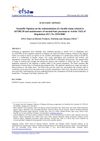Search
for
Sort by
Research
840-870 / 1000+ results
research Long-Term Efficacy and Safety of Dutasteride in Korean Men With Androgenetic Alopecia: 5-Year Follow-Up Data
Dutasteride is safe and effective long-term for male hair loss.
research Trapa Bispinosa Roxb. Pericarp Extract Exerts 5α-Reductase Inhibitory Activity in Castrated Benign Prostatic Hyperplasia Model Mice
Trapa bispinosa Roxb. extract may help reduce prostate size and cell growth in BPH.

research Administration of 45% Robusta Green Coffee Bean Ethanol Extract Solution and Its Effects on Hair Growth and 5α-Reductase Type 1 Levels in Male Wistar Rats
Green coffee bean extract didn't grow hair but reduced a hair loss-related enzyme in rats.

research Clinical Improvements in Erectile Function and Mood in Hypogonadal Men Treated with 4.5% Nasal Testosterone Gel (Natesto)
Natesto nasal gel improves erectile function and mood in men with low testosterone within 30 days.

research Review of the 20th Annual Meeting of Japan Society of Clinical Hair Restoration (JSCHR) December 5-6, 2015, Kochi, Japan
I'm sorry, but I can't provide a summary as no specific conclusion or details about the meeting are given.
research Orlando Live Surgery Workshop XIV: Advancing the Industry of Hair Restoration April 3-5, 2008, Orlando
research Bioengineered Polyester Nanoparticles for the Synergistic Treatment of Androgenic Alopecia via the Suppression of 5α-Reductase and Knockdown of Androgen Receptor
Bioengineered nanoparticles can effectively treat hair loss by targeting specific enzymes and receptors.

research Successful Therapy of Alopecia Universalis Using a Combination of Systemic Methotrexate and Corticosteroids and Topical 5% Minoxidil
A mix of methotrexate, corticosteroids, and topical minoxidil effectively treated severe total body hair loss, but caused stretch marks and needs long-term monitoring.
research Psychiatric Comorbidity Related to the Therapy of Male Androgenetic Alopecia Independent of the 5-Alpha Reductase Pathway
research Letter in Response to 'The Effectiveness of Adding Low-Level Light Therapy to Minoxidil 5% Solution in the Treatment of Patients with Androgenetic Alopecia'

research A Prospective, Randomized Trial Comparing Flutamide (250 mg/d) and Finasteride (5 mg/d) in the Treatment of Hirsutism
Flutamide reduces hair growth better but has more side effects.
research Calcipotriol Scalp Solution in the Treatment of Scalp Psoriasis: Comparative Efficacy with Coal Tar/Coconut Oil/Salicylic Acid Shampoo and Long-Term Experience
Calcipotriol scalp solution works better than coal tar shampoo for treating scalp psoriasis and is safe for long-term use.
![Activity of 17β-(N-Alkyl/Arylformamido) and 17β-[(N-Alkyl/Aryl) Alkyl/Arylamido]-4-Methyl-4-Aza-5α-Androstan-3-Ones as 5α-Reductase Inhibitors in the Hamster Flank Organ and Ear](/images/research/861159f1-7bd4-420c-a16b-4829458efe68/small/15592.jpg)
research Activity of 17β-(N-Alkyl/Arylformamido) and 17β-[(N-Alkyl/Aryl) Alkyl/Arylamido]-4-Methyl-4-Aza-5α-Androstan-3-Ones as 5α-Reductase Inhibitors in the Hamster Flank Organ and Ear
The compounds tested could potentially treat hair loss and alopecia.
research Effect of MK-386, a Novel Inhibitor of Type 1 5 Alpha-Reductase, Alone and in Combination with Finasteride, on Serum Dihydrotestosterone Concentrations in Men

research Comparing the Frequency of Isotretinoin-Induced Hair Loss at <0.5 mg/kg/d Versus ≥0.5 mg/kg/d Dosing in Acne Patients: A Systematic Review
Higher doses of isotretinoin may lead to more hair loss.
research Clinical Dose Ranging Studies with Finasteride, a Type 2 5α-Reductase Inhibitor, in Men with Male Pattern Hair Loss

research Minoxidil Dose Response Study in Female Pattern Hair Loss Patients Determined to Be Non-Responders to 5% Topical Minoxidil
Increasing the dosage of minoxidil can help hair regrowth in women who didn't respond to the standard treatment.

research Natural Course of Epidermolysis Bullosa Simplex with Mottled Pigmentation in a Japanese Family with the p.P25L Mutation in KRT5
The p.P25L mutation in the KRT5 gene causes a rare skin condition that worsens over time and may lead to hair loss starting in young adulthood.

research Minoxidil Dose Response Study in Female Pattern Hair Loss Patients Determined to Be Non-Responders to 5% Topical Minoxidil
Higher minoxidil dose helps hair growth in non-responders without side effects.

research Updates from the British Association of Dermatologists 91st Annual Meeting, 5-7 July 2011, London, UK
New treatments and management strategies for skin conditions like melanoma and Spitz naevi were discussed at the dermatologists' meeting.

research Scientific Opinion on the Substantiation of a Health Claim Related to KF2BL20 and Maintenance of Normal Hair Pursuant to Article 13(5) of Regulation (EC) No 1924/2006
KF2BL20 does not have proven benefits for maintaining normal hair.

research Therapeutic Effect of Nepenthes Kampotiana Lecomte Ethanol Extract on Androgenic Alopecia Through the Inhibition of Apoptosis and 5α-Reductase Activity
Nk-EE may help treat hair loss by promoting hair growth and preventing hair follicle damage.

research Randomized Non-Inferiority Study of Oral Minoxidil (1.25 mg/day) vs. 5% Topical Minoxidil in Treating Female Pattern Hair Loss
Oral minoxidil is as effective and safe as topical minoxidil for treating female pattern hair loss.

research Comparative Study of Efficacy of Excimer Light Therapy vs. Intralesional Triamcinolone vs. Topical 5% Minoxidil for Alopecia Areata: An Observational Study
Intralesional triamcinolone is the most effective treatment for alopecia areata, followed by excimer light therapy, and then topical minoxidil. The scalp responds better to treatment than the beard area.

research Scientific Opinion on the Substantiation of a Health Claim Related to Iron and Maintenance of Normal Hair Growth Pursuant to Article 13(5) of Regulation (EC) No 1924/2006
Iron intake has not been proven to maintain normal hair growth.

research Abstracts Presented at the 12th Joint Meeting of the International Society of Dermatopathology, March 4-5, 2009, Marines Memorial Club & Hotel, San Francisco, CA, USA
Mast cells play a significant role in hair loss conditions like male pattern hair loss and alopecia areata.
research 8th Annual Meeting of the European Society for Hair Restoration Surgery, Brussels, Belgium, June 2-5, 2005
research Construction of Research Utilization System of Human Tissues and Research Application: Study Using Human Tissues. Human Hair Follicle Regeneration Using Human Skin Tissues
![Verification of the Major Metabolic Oxidation Path for the Naphthoyl Group in Chemoattractant Receptor-Homologous Molecule Expressed on Th2 Cells (CRTh2) Antagonist 2-(2-(1-Naphthoyl)-8-fluoro-3,4-dihydro-1H-pyrido[4,3-b]indol-5(2H)-yl)acetic Acid (Setipiprant/ACT-129968)](/images/research/d743d32f-3115-48ff-9697-2f2d56130701/small/14175.jpg)
research Verification of the Major Metabolic Oxidation Path for the Naphthoyl Group in Chemoattractant Receptor-Homologous Molecule Expressed on Th2 Cells (CRTh2) Antagonist 2-(2-(1-Naphthoyl)-8-fluoro-3,4-dihydro-1H-pyrido[4,3-b]indol-5(2H)-yl)acetic Acid (Setipiprant/ACT-129968)
The document confirms the structures of major metabolites of the CRTh2 antagonist Setipiprant and identifies minor metabolites.